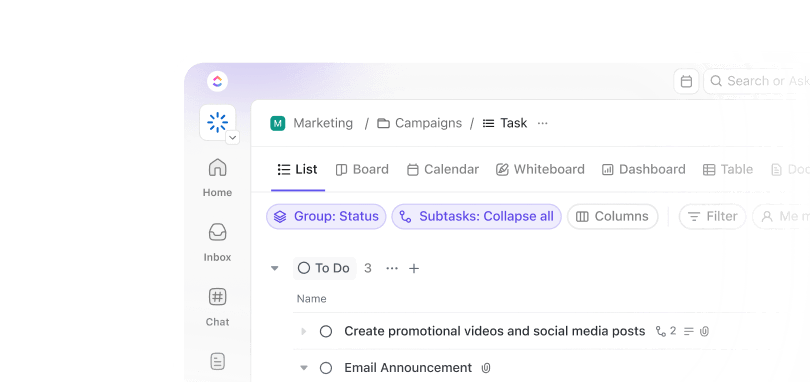You’re managing a project with a global team and tight deadlines when disaster strikes! A sudden vendor delay throws everything off track. What do you do now?
Risks like these are inevitable, but how you handle them determines your project’s success. Risk response strategies are your game plan for tackling uncertainties, helping you stay in control and adapt effectively.
Beyond avoiding disruptions, these strategies can uncover new opportunities and strengthen project outcomes. With the right risk management software, you can improve risk mitigation, from identifying threats to implementing solutions seamlessly.
This guide will help you create a resilient risk response plan that covers all your bases, from project cost risks to unmet project objectives.
Implementing Risk Response Strategies in Project Management
⏰60-Second Summary
- Risk response strategies are essential for tackling uncertainties in project management
- These strategies help minimize negative impacts and seize opportunities from calculated risks
- Key strategies include risk avoidance, mitigation, transfer, and acceptance:
- Avoidance involves not taking on risks that could disrupt project execution
- Mitigation focuses on reducing the likelihood or impact of risks
- Transfer shifts the responsibility of risk consequences to a third party
- Acceptance involves acknowledging low-impact risks without active intervention
- Effective risk response requires identifying, assessing, and prioritizing risks
- Assigning ownership and monitoring strategies are crucial for successful implementation
- Tools like can streamline risk management through proactive task assignment and capacity planning
- You can also use risk assessment and risk register templates in to document risks, assign responsibilities, and prioritize actions, ensuring a structured approach to risk management
What are Risk Response Strategies?
Risk response strategies are essential components of project management. They are designed to identify, assess, and address potential uncertainties that could disrupt progress.
These strategies are not just reactive measures but also proactive plans that empower project managers to anticipate challenges and maintain control.
The purpose of risk response strategies
The purpose of risk response strategies is twofold: to minimize the negative impact of risks on project goals and to seize opportunities that arise from calculated risks.
Integrating these strategies into your project plan early ensures alignment between team efforts and organizational objectives, avoiding last-minute disruptions.
To begin, it’s essential to identify and assess potential risks in your project. Assess how likely these risks are to happen and how they could impact your project. This step helps you understand which risks are manageable and which should be avoided.
Your response strategy can affect the project in several ways, including:
- Introducing new workflows and processes to handle the identified risks better
- Requiring adjustments to the project scope, such as changing tasks or deliverables
- Modifying the project schedule to account for additional activities needed to manage risks
- Necessitating the hiring of specialists or professional services to handle specific risk areas
Integrate your risk response strategy with your initial project plan for the best results. Developing these plans together ensures alignment and avoids last-minute fixes. A disjointed approach can lead to ineffective strategies that fail to address core issues.
👀 Did You Know? The concept of managing risk dates back to 3,000 BC in ancient Mesopotamia, where traders used early forms of insurance to manage the risks of maritime trade.
The importance of planning for risks
In April 1970, Apollo 13 launched from Earth, carrying three astronauts—Jim Lovell, Jack Swigert, and Fred Haise—on a mission to the Moon. Everything was going smoothly until two days into the mission, when an explosion rocked the spacecraft. The crew suddenly found themselves in a life-or-death situation: their main oxygen supply was gone, their power was failing, and carbon dioxide was rising to lethal levels.
Back on Earth, NASA’s mission control in Houston didn’t panic—they planned. Years of risk management training kicked in. The engineers knew they didn’t have spare parts floating around in space, so they had to work with what was already onboard.
On the ground, NASA engineers grabbed duct tape, plastic bags, and spare flight manuals—the same materials the astronauts had in space—and started prototyping a fix. After hours of trial and error, they came up with a makeshift CO₂ scrubber. They relayed the instructions to the Apollo 13 crew, who, under extreme pressure, assembled the life-saving device using nothing but their hands and a little ingenuity. It worked.
Thanks to NASA’s meticulous risk planning and real-time problem-solving, what started as a crisis became a defining moment in space exploration—proving that prepared teams don’t just avoid disasters, they innovate their way out of them.
Effective risk response strategies are critical to project success. Planning for risks allows project managers to anticipate challenges, allocate resources effectively, and ensure smooth execution.
Without proper planning, risks can lead to costly delays, budget overruns, and unmet objectives, and, in extreme cases like NASA’s, the possibility of death.
Moreover, a well-thought-out plan doesn’t just prevent disruptions—it can foster innovation. By addressing risks early, teams can explore new workflows, uncover hidden efficiencies, and identify valuable opportunities that might have been overlooked otherwise.
Types of Risk Response Strategies
Your risk response strategy can be divided into one of four main categories. The category you choose will depend on factors such as the types of risks in your project and your team’s risk tolerance.
It’s important to remember that your risk response strategies can change as the project progresses. You might need to adapt if the project requirements shift or new managers join.
Here are the four main risk response strategies to consider:
1. Avoidance
Avoiding a risk means deciding not to take it on at all. It could involve delaying an entire project because of high uncertainty or removing specific tasks that introduce unnecessary complications.
This approach ensures that the identified risk has no opportunity to disrupt project execution or endanger your organization. It is significant for scenarios involving legal liabilities, employee safety concerns, or risks that far outweigh potential benefits.
🔑 Key Insight: Avoidance is a negative risk response strategy often viewed as a last resort, especially if accepting some risk could result in substantial gains based on the overall project analysis.
Before avoiding a risk, project managers should carefully weigh the pros and cons, leveraging tools like a risk assessment matrix to understand the potential severity and outcomes.

In cases where avoiding risk means modifying the project structure, project risk management software like can help. simplifies project execution by offering clear task overviews, allowing you to keep every team member accountable and your project on track.
Use Tasks to refine timelines, reassign responsibilities, or eliminate risky tasks altogether. Effectively assigning tasks to the right team members is crucial in managing deadlines and maintaining productivity.


The Assign Comments feature ensures smooth communication when assigning tasks. This tool lets you directly assign comments to team members for action, track updates, and resolve issues within any task workflow.
Keeping all communication in one place minimizes the risk of missed details or miscommunication, helping your team stay on top of potential risks and stay aligned throughout the project.
💡Pro Tip: Distribute tasks thoughtfully, considering individual skill sets, deadlines, and workload capacity. This ensures that every member contributes to their fullest potential.
2. Mitigation
Reducing risk means taking specific actions to lower its likelihood or potential impact. This strategy is sound when a risk slightly exceeds your organization’s tolerance level.
By applying reduction techniques, you can bring the risk within acceptable limits without compromising progress.
👉🏼Think of everyday life. When you put on a seatbelt, you reduce the harm that might result from an accident. While this doesn’t prevent accidents altogether, it minimizes their effects.
The same principle applies to project analysis—you take measures to mitigate risks without overextending resources. In business, balancing effort and value when mitigating risks is essential. Spending excessive time and money on trivial risks isn’t efficient.
🔑 Key Insight: Imagine a business tolerating a $3 cash drawer discrepancy. If someone spent hours reconciling a $1.50 error, the cost or time spent wouldn’t justify it.
The goal is to address significant risks while avoiding unnecessary focus on minor, inconsequential issues.
Mitigation tasks often require regular check-ins to review progress and confirm that dependencies are resolved. With Reminders, following up on these tasks becomes super easy.


You can set reminders for specific tasks and customize notifications to ensure nothing is missed. Define when and how you want to be notified—on the due date, 10 minutes before, or at a custom time.
You can even attach relevant files to reminders for quick access during updates.
Delegation is just as simple. Assign reminders to team members, track their progress, and mark them as done when they complete them.
3. Transfer
Transferring risk means assigning responsibility to another entity without eliminating or mitigating the risk itself. This approach ensures that when a risk occurs, the burden of addressing the consequences shifts to a third party, often through contracts or agreements.
👉🏼Business insurance is a classic example of this strategy. While an insurance policy doesn’t remove the risk of unforeseen events, it ensures that the insurance company manages the financial fallout when issues arise.
This method protects your project or company from bearing the full brunt of specific risks.
🔑 Key Insight: Not all risks can be transferred. Risks tied to brand perception, reputation, or workforce cannot be shifted to others. Additionally, this strategy only activates after the risk event, making it vital to consider its limitations during project planning.
Effective collaboration often involves third parties, and simplifies these interactions with Integrations.


By connecting tools like Slack, Google Drive, and GitHub, ensures seamless communication and data sharing. This functionality eliminates the need to switch between platforms, streamlining workflows.
With every tool working together in one place, your team can focus on what matters without distractions or inefficiencies.
👀 Did You Know? The earliest example of life insurance was of William Gibbons, a salt merchant in London, whose acquaintances took out a policy on his life in 1583. When he died in the final month of the policy, the underwriters tried to avoid paying out but were unsuccessful in court.
4. Acceptance
Acceptance is the most straightforward response to certain risks. When a risk has a low probability or minimal impact, it often falls within acceptable project thresholds.
In such cases, actively addressing the risk may be unnecessary, significantly if mitigation costs outweigh the potential consequences.
🔑 Key Insight: Choosing to accept a risk doesn’t always mean taking no action. Monitoring the situation or collaborating with others to share the burden can be a strategic decision.
👉🏼For instance, partnering with another company could distribute the impact if the risk materializes. This method ensures resources remain focused on more pressing concerns while maintaining awareness of less critical issues.
helps manage accepted risks effectively by allowing you to set reminders for ongoing monitoring. Use these reminders to track the status of risks and ensure timely action when circumstances change.
Creating an Effective Risk Response Plan
Knowing how to create a risk response strategy is primarily the project manager’s responsibility. With their experience and expertise, these professionals anticipate foreseeable risks and make them accountable to teams, stakeholders, and customers.
Although it’s a big responsibility, risk response plans add value to the development process by preventing and mitigating the effects of adverse risks. Project managers also encourage positive risks, potentially unlocking new opportunities and resources.
Let’s break down the key steps for creating and implementing a risk response plan:
1. Identify risks
Risk identification can involve brainstorming and SWOT (strengths, weaknesses, opportunities, threats) analysis. You should work closely with IT teams to integrate cyber and non-cyber risk management efforts whenever possible.
This helps create a comprehensive view of potential risks.
Maintain a detailed list of all identified project risks and assign team members to manage and update these lists. This is where can genuinely make a difference.
By centralizing your tasks, discussions, and updates in one place, ensures everyone is on the same page. With Collaboration Detection, you can track tasks quickly, providing transparency across your risk management process.


For more interactive collaboration, Whiteboards offer an ideal space to brainstorm and organize ideas.
The tool’s customization options make it perfect for:
- Mapping out potential risks and mitigation strategies through mind mapping or SWOT analysis
- Sharing ideas with your team by embedding sticky notes, comments, media files, and links
- Collaborating on solutions with charts, graphs, and color-coded shapes
With real-time updates and notifications, your team will always be informed of the latest risk status and task progress.
2. Perform a risk assessment
Evaluate each risk using qualitative and quantitative methods.
- Qualitative assessment: Assign risk levels based on likelihood and severity. Use tools like risk matrices or expert judgment to categorize risks as low, medium, or high impact
- Quantitative analysis: Measure risks using data—probability models, financial impact assessments, or Monte Carlo simulations—to estimate potential losses or disruptions
Prioritize these risks based on their potential impact on your project or business operations.
By assessing risks, you can allocate resources effectively to the areas needing attention in your project management plan.
💡Pro Tip: Use risk assessment templates to identify potential threats early and create actionable response plans. These templates break down risks into different stages, using organized tables to document identified threats and assign responsibility to the relevant parties.
👉🏼For example, the Risk Assessment Whiteboard Template helps your team visualize, capture, and prioritize risks based on their likelihood and impact.
This tool streamlines real-time risk evaluation, keeping everyone aligned and ready to address potential challenges efficiently.
It lets you:
- Assess different types of risks and their potential impact on your project
- Pinpoint critical areas of concern through data analysis
- Develop actionable strategies to minimize risk and reduce exposure
3. Analyze risk triggers
Understanding risks fully requires identifying the events or conditions that could trigger them. By closely monitoring your environment for potential triggers, you can detect risks early and take proactive measures.
👉🏼 A classic example is the airline industry’s handling of weather patterns.
Airlines face the constant risk of flight delays and cancellations due to severe weather conditions. Instead of reacting only when a storm hits, they monitor real-time weather data to identify potential triggers—such as hurricanes, snowstorms, or high winds.
By tracking these indicators early, airlines can reroute flights, adjust schedules, and notify passengers in advance, minimizing disruptions. This proactive approach reduces customer frustration, avoids operational chaos, and even saves costs on last-minute rescheduling.
Automated monitoring tools are essential for staying on top of potential risks.
Automations simplify risk monitoring, alerting you when a risk-triggering event occurs. You can customize workflows to track specific conditions and set up automatic tasks or alerts when any risk events or triggers are detected.


For example, to monitor assumptions related to team availability:
- Set the trigger: Define a scenario where three team members are unavailable simultaneously
- Specify the action: Create an automation that sends an alert within , notifying you of the issue so you can step in immediately and prevent project delays
This level of automation helps you stay ahead of risks and mitigate their impact, ensuring smoother project execution.
Watch this video to learn how to make the most of automations in .
💡 Pro Tip: Use risk register templates to identify, assess, and track risks, ensuring you meet deadlines and avoid potential setbacks. A typical risk register template includes sections for each risk description, its potential impact, and the likelihood of occurrence.
4. Define a risk response plan
Choose suitable strategies for each identified risk. Options include risk avoidance, reduction, retention, spreading, transference through contracts or insurance policies, and risk acceptance.
Documenting, distributing, and regularly testing these strategies ensures their effectiveness.
Using ’s readymade templates can standardize and streamline your risk response plans. This ensures that each plan follows a consistent, organized approach across all projects.
For example, the Risk Register Template offers customizable folders and modules for effectively building and managing your project risk register. It helps you track risks across multiple projects, enabling better visibility of potential issues that could impact project success.
5. Designate risk owners
Assign specific responsibilities to team members. Make sure everyone understands their roles and responsibilities when it comes to managing risks.
Review these assignments regularly and update them as needed, mainly if changes occur in the team or the risk landscape.
6. Implement the risk management plan
Once your risk response plan is ready, it’s time to implement it. Notify all involved team members and stakeholders to ensure the plan is understood and well-executed.
Make sure the implementation of these contingency plans causes minimal disruption to ongoing business operations.
Tasks should be assigned to the appropriate people, and any updates or changes should be communicated in real time.
This way, everyone can stay informed and react quickly to unforeseen challenges.
💡 Pro Tip: Use the Risk Management Template to ensure smooth execution and minimal disruption to ongoing operations. This template offers a structured framework that effectively helps you implement and monitor your risk management strategies.
7. Monitor and review
After implementation, it is crucial to monitor and review your risk management efforts regularly. Set up steps and schedules to ensure each plan is thoroughly tested and updated as necessary.
Keep monitoring your risks using automated notifications and updates.
makes ongoing monitoring easy. You can use automations to set up recurring tasks for risk reviews and audits, ensuring nothing is overlooked.
Additionally, use Dashboards to track the progress of each risk management effort, providing real-time insights into the success of your risk response strategies.


Track each risk, mitigation progress, and team member involvement through easily customizable charts, tables, and more.
How to Implement Risk Response Strategies
Effective risk response strategies require careful planning, execution, and continuous monitoring. Tools like can ensure that each process stage is managed efficiently.
Let’s explore how you can implement risk response strategies effectively in your projects.
Risk identification and prioritization


The first step in implementing risk response strategies is identifying and prioritizing risks. With ’s Custom Fields, you can easily categorize and assign priority levels to each risk.
These fields allow you to track key factors like risk severity, likelihood, and potential impact in a manageable, visual format.
For example, you can create Custom Fields to define whether a risk is a high, medium, or low priority. This helps your team focus on the most critical risks and allocate resources effectively.
🧠 Fun Fact: Risk management often applies the “Pareto Principle,” or the 80/20 rule. It states that 80% of problems come from just 20% of causes, which helps teams prioritize the most critical risks for greater efficiency in mitigation.
Assigning ownership
Once you’ve identified and prioritized risks, it’s time to assign ownership. By assigning tasks and setting clear due dates, you clearly define who manages each risk and by when.
Using task assignments also helps track progress. Team members can update their tasks, add comments, and attach files, keeping all related information in one place.
This ensures that no aspect of the risk response is overlooked and that every team member knows exactly what’s expected of them.
Monitoring and adjusting strategies
Monitoring the effectiveness of your risk response strategies is essential to ensure you stay on track. Dashboards comprehensively overview all active risks and their management status.
You can customize these dashboards to display the most critical metrics for each risk—such as its severity, the response plan in place, and whether it has been mitigated.
If a risk escalates or a response strategy is not working as expected, you can adjust your approach quickly and notify the relevant team members to take corrective actions.
This centralized overview ensures that risks are continuously managed and your team remains agile in responding to new challenges.
Challenges in Risk Response Planning
While creating and implementing a risk response plan is essential for project success, several challenges can arise. Preparing for these issues and knowing how to overcome them will ensure your plan is effective.
Below are some of the most common challenges:
- Unclear risk prioritization: Teams may waste time and resources on less critical issues without clearly understanding which risks to address first. To overcome this, ensure you prioritize risks based on severity and likelihood
- Lack of clear communication: Teams may not be aligned on the response strategies, leading to inconsistent execution. To combat this, all communication must be centralized and transparent
- Incorrect ownership: Finally, a lack of clarity on roles and responsibilities can create confusion during execution. Avoid this by assigning each risk to a specific team member
Aligning team and stakeholder understanding
One of the biggest challenges in risk response planning is ensuring that both your team and stakeholders fully understand the strategies in place. Miscommunication can lead to confusion, slow decision-making, and even failed risk mitigation efforts.
- When risks are identified, immediately update tasks, share them with relevant team members, and ensure stakeholders have visibility into the plan
- Create shared task lists and use assigned comments to keep everyone in the loop. This will keep communication open and ensure no one is left out of the decision-making process
- It’s also essential to hold regular check-ins. Schedule meetings using recurring tasks to review progress, discuss potential new risks, and update stakeholders
This consistency in communication will prevent misunderstandings and ensure alignment as the project progresses.
Additionally, automation should notify stakeholders when important updates or decisions are made, ensuring everyone is in the loop.
This centralized, real-time approach ensures that both team members and stakeholders are aligned, reducing misunderstandings and increasing the effectiveness of your risk management strategies.
Manage Your Risk Response Effectively With
Implementing risk responses is essential for organizations looking to manage and mitigate risks. Businesses can improve their resilience by systematically addressing risks and continuing to progress despite uncertainties.
A structured risk approach ensures organizations can handle potential threats while seizing new opportunities as they arise. The right tools and active stakeholder involvement are crucial for successfully executing these strategies.
provides the perfect solution for streamlining risk management. With tools like Dashboards, Docs, and ready-made templates, you can track risks, streamline processes, and collaborate seamlessly.
Sign up for today to start managing risk—for free!


Everything you need to stay organized and get work done.













